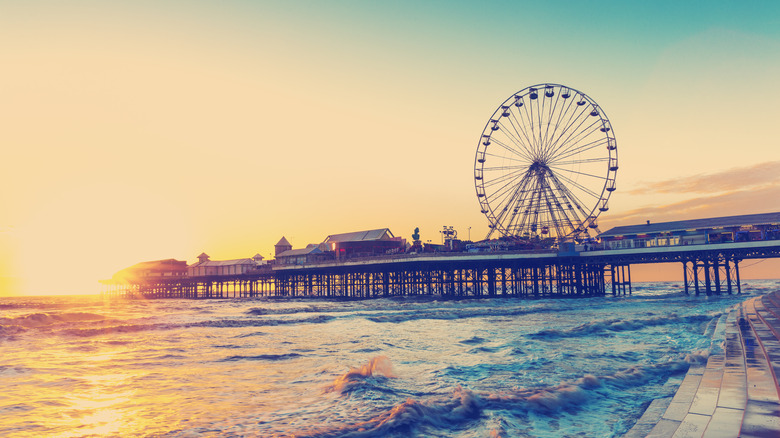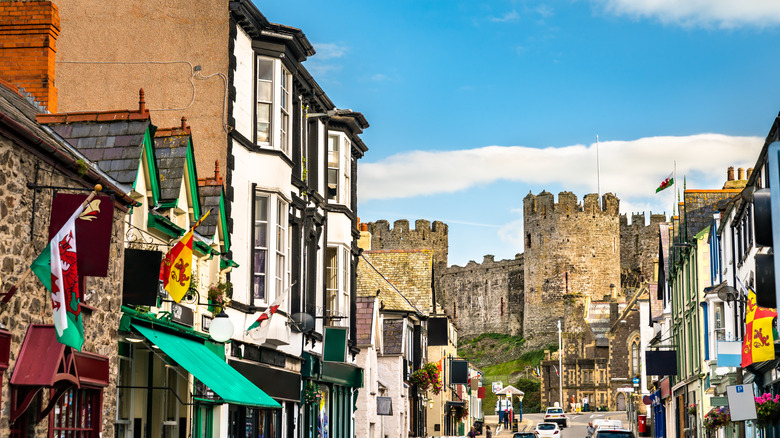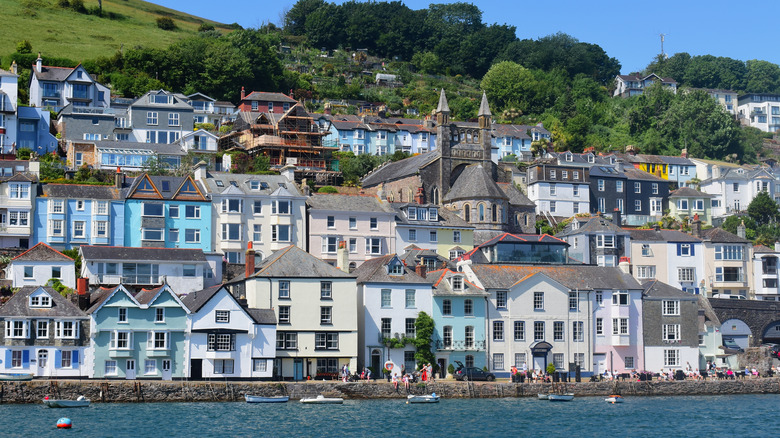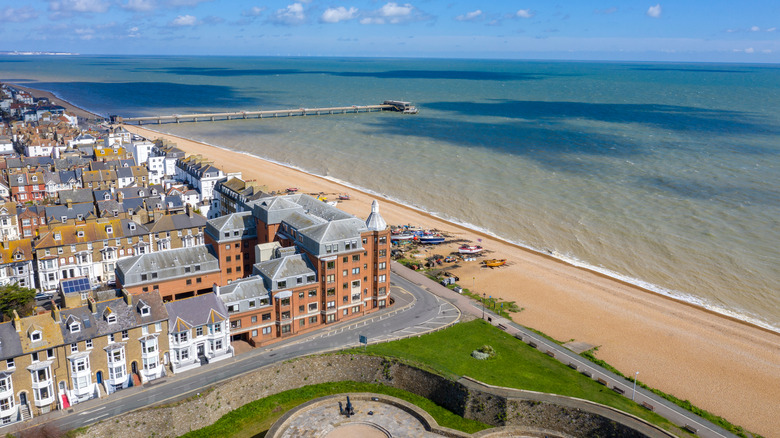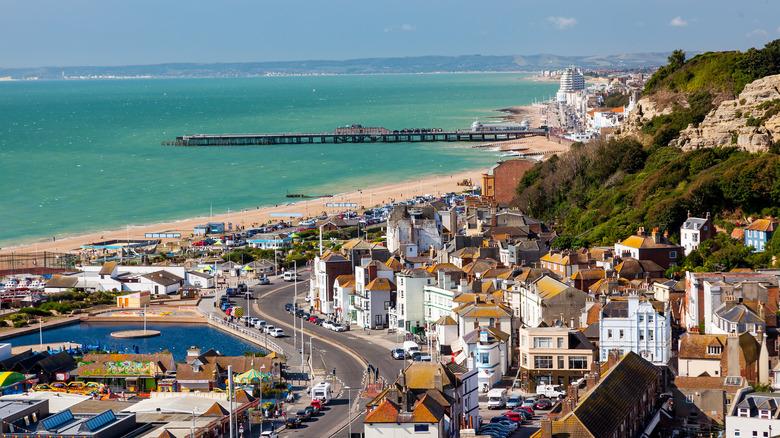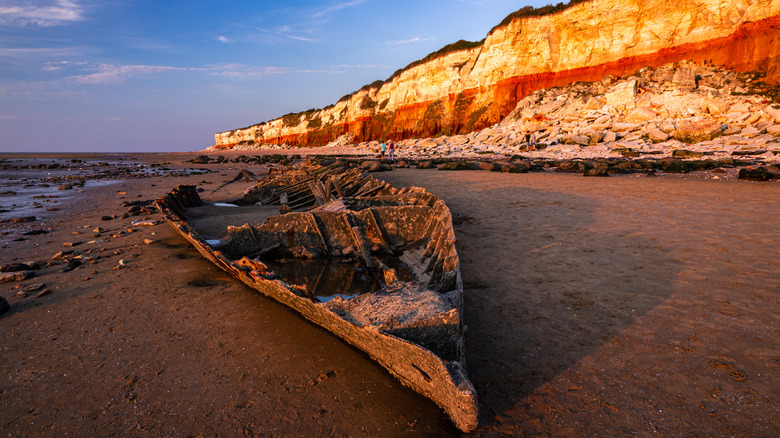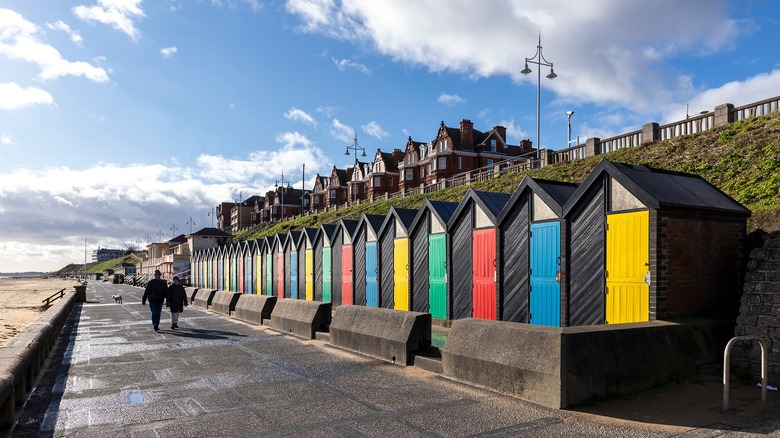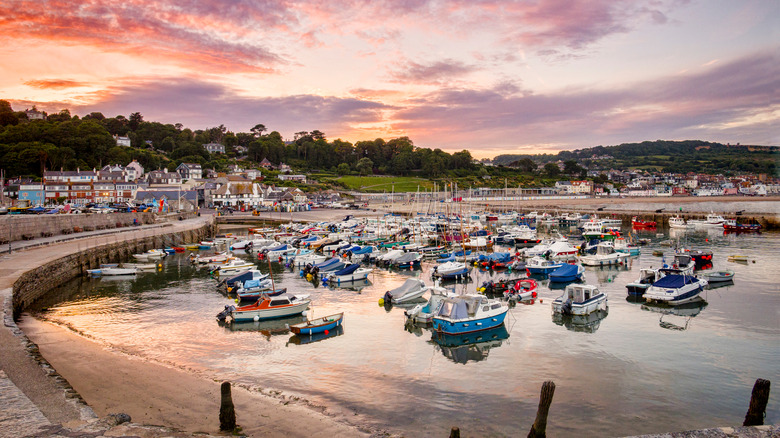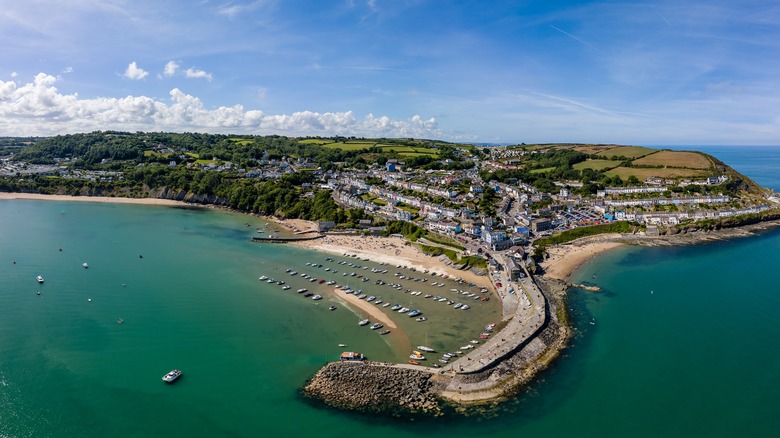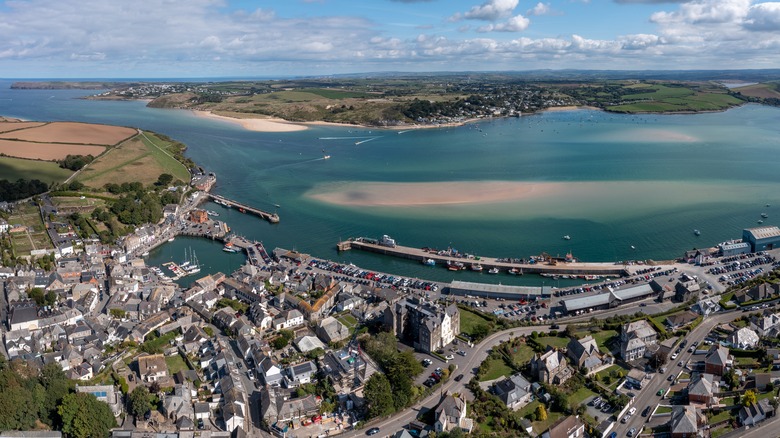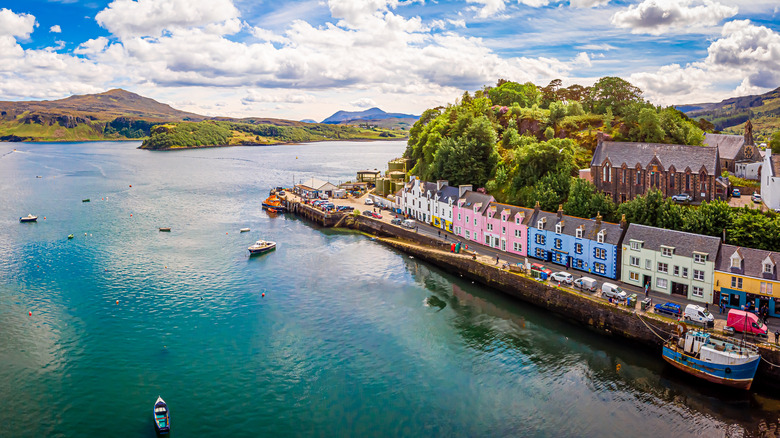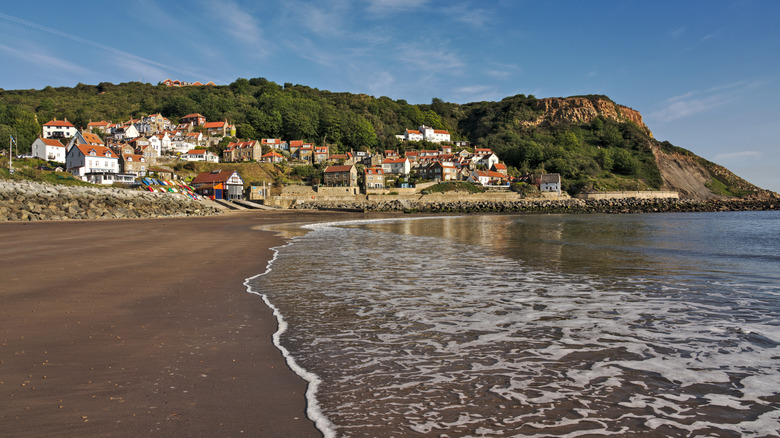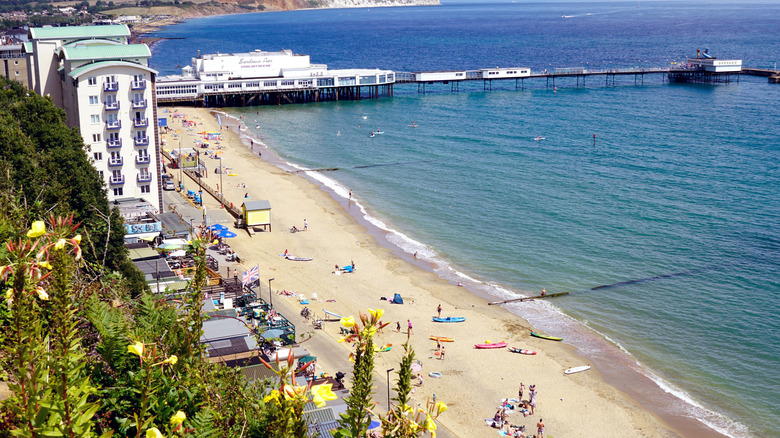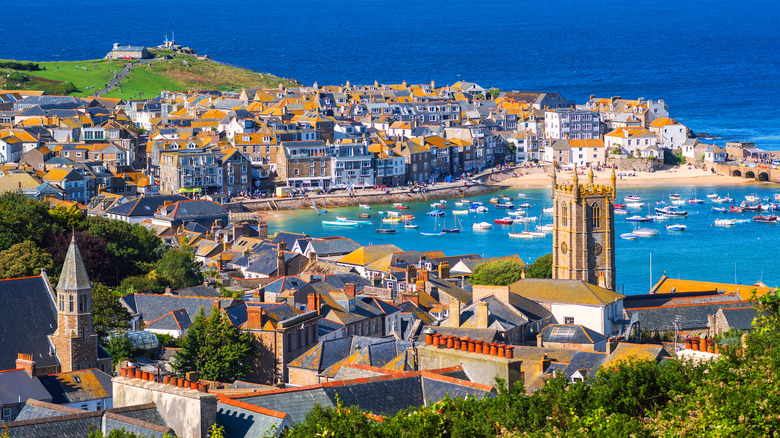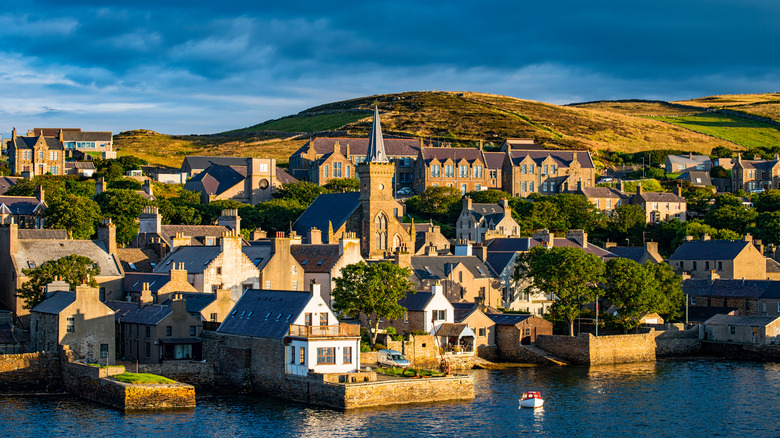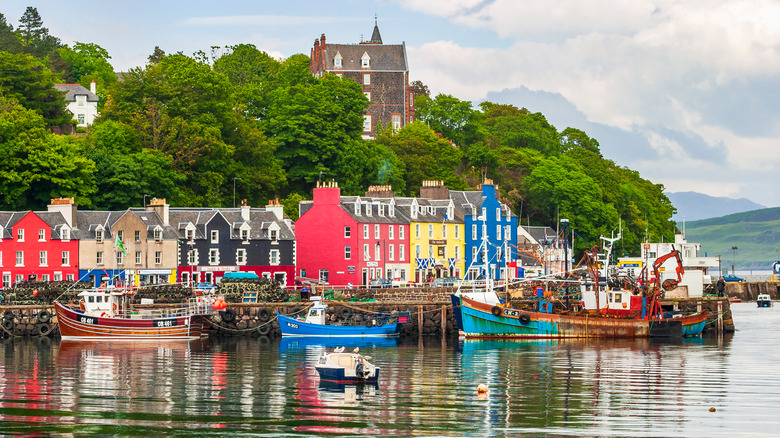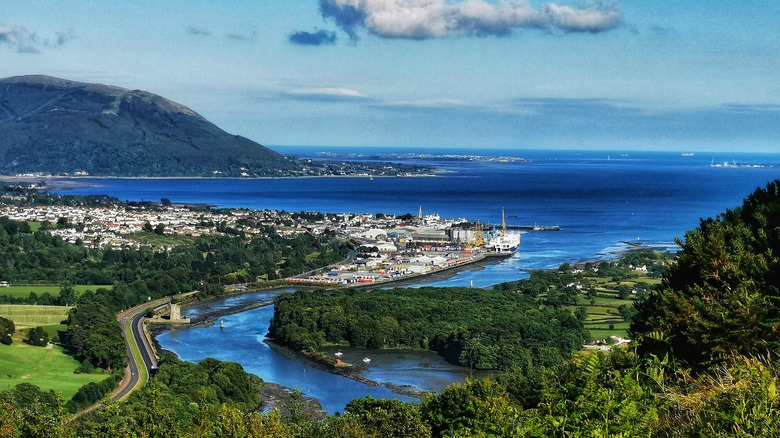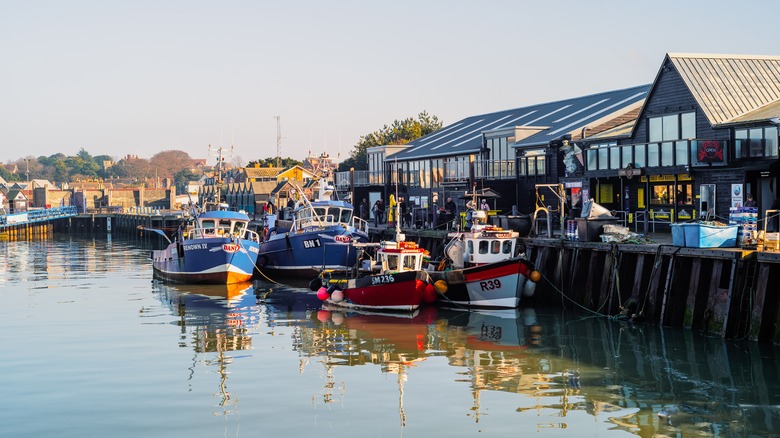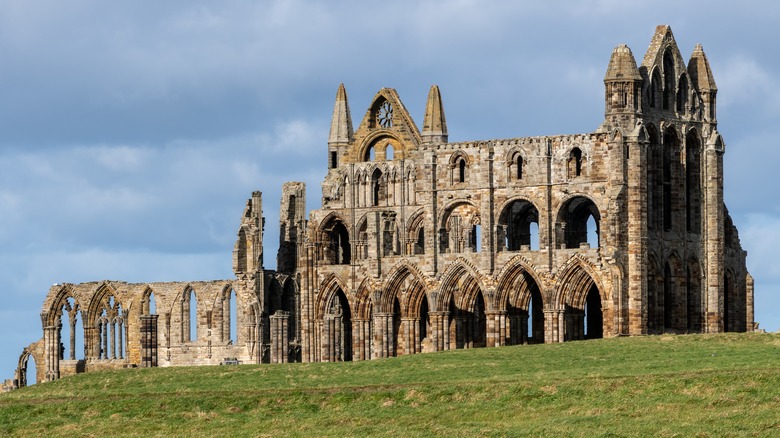18 Scenic Beach Towns Along The UK's Coast
Brits of a certain era — and perhaps fans of the kids' show "Thomas the Tank Engine" — will be familiar with the song "I Do Like to be Beside the Seaside." Written in the early 1900s, it is a jaunty tune from the Victorian age, chaste and cheery, recounting the multifold delights of spending time by the water's edge, from the sight of the sea and its shells to the pomp and pageantry of the bands that play nearby.
The United Kingdom — comprising England, Northern Ireland, Scotland, and Wales — is a region blessed with more than 7,500 miles of coastline, and going to the sea is an annual highlight for many of its residents. Yes, the water might not always be warm enough for a leisurely swim, but the restorative effects of a bracing dip are always welcome. There are coastal towns and villages up and down the U.K. that draw visitors, each with their particular allure, amenities, and ease of access. But some have a greater pull than others, like little charmers that guarantee a dreamy dose of delight. Here are 18 U.K. beach towns worth checking out.
Conwy
Located in North Wales, a 90-minute drive from the English town of Liverpool, this waterfront gem is anchored by its sturdy castle, which has a truly commanding presence. Characterized by towers that punctuate the sky, the castle is part of a series of fortresses with great historic import, earning them a place on the Unesco World Heritage site list. Yet it's just one of the many things to see here. In the heart of town, Plas Mawr is a well-preserved example of an Elizabethan house, hundreds of years old.
Nature lovers will also enjoy time at Bodnant Garden, where reflecting pools, lily ponds, and manicured lawns weave an atmosphere of pastoral serenity. Conwy is also home to a house with a bright red facade that is purported to be the smallest house in Great Britain! Beaches abound in the area, but perhaps the finest is the long sandy stretch of Conwy Morfa, where visitors will stumble upon mussels at low tide.
Dartmouth
This town gets its name from its position — it hugs a hilly shore at the mouth of the River Dart, where it meets the English Channel. Come here and you'll experience a classic English seaside town, with shops arrayed in narrow lanes with cobbled streets and a pretty waterfront suited to a leisurely stroll. These lures haven't made the town immune to vacationers and those in search of a finer quality of life, and while Dartmouth has always had a strong naval background, the large number of slick yachts docked in its marina testify to the influx of new money.
Many are drawn by the fabulous beaches, with Sugary Cove particularly notable for its location by Dartmouth Castle. In town, you'll find that there are plenty of shopping options and things to do. There is also a lively art scene here, with galleries dotted around the city's center hosting lively gallery weeks during the warmer parts of the year.
Deal
It's a short drive from this town in southern Kent to the famed White Cliffs of Dover, but visitors might be just as happy to stay put in Deal and enjoy its multitude of sights. From anywhere on the waterfront, the long pier that reaches out into the English Channel is a defining image of the town, popular with amateur anglers, or couples and families out for a breezy stroll. The views of the town from the pier are magnificent and for famished travelers, a hip restaurant at the end of the pier serves brunch and lunch throughout the week.
A promenade along the water leads down to a broad stone beach, pleasing to walk along for the rewarding crunch sound underfoot, and visitors can see Deal Castle from it, a Tudor spectacle built by Henry VII as a coastal defense. The town center is also an enjoyable place to wander, with meandering streets, and quaint pastel-shaded homes.
Hastings
This seaside town gives its name to the famous battle that all schoolchildren learn about — the grand Battle of Hastings, fought in 1066, and marking a turning point in the seat of power, from England to France. That moment in history took place in Battle, a few miles inland from Hastings, but the seaside settlement is definitely the more interesting of the two. A good start is the old town, in existence since the Middle Ages, and home to aged buildings, ornate churches, narrow alleys, and fishing boats galore.
The town is also a scenic joy, seated between hills that cup its homes and streets and even has ruins of a castle built by William of Normandy (more famously known as William the Conqueror after winning the Battle of Hastings) in 1067. It's set high above the town, affording glorious views of the sea, and the sandy/rocky beach that it neighbors.
Huntstanton
Geologists will be able to explain what gives the red-striped cliffs here their unique Mars-like glow, but for the rest of us, to simply look at this vibrant rock face is a huge thrill in itself. These cliffs are truly a sight to behold, with bands of color across them, like a layered cake of chalk. It's one of the main attractions of this town in Norfolk, a county that forms part of the rump that sticks out from the east of England.
Hunstanton grew in the Victorian times, developed as a seaside getaway, and it manages to retain that feel of a summer haunt, with amusement arcades, shops selling the beloved fish and chips, and family-friendly, low-tech options like crazy golf and kid-friendly carnival rides. Esplanade Gardens is a comely piece of manicured greenery near the waterfront promenade, while the real outdoor jewel is the sandy beach, unraveling under those zany, stripy cliffs.
Lowestoft
The renowned composer Benjamin Britten was born here in 1913, and visitors to Lowestoft, the most easterly town in the United Kingdom, can stay at the Victorian house where he grew up — it now serves as a bed and breakfast. The sandy beaches here are fine vantage points to catch a sunrise given their orientation, and a great way to kick-start the day before enjoying the town's other lures.
The broad, deep beach that straddles Claremont Pier is busy during peak summer, and spend some time here, and you'll know why — it's a sparkler. After a stroll along the water, travelers can stop by the East Point Pavilion, set just behind the beach and distinctive for its large glass windows, for a morning cuppa or bite to eat. In town, walk around the slender lanes known as The Scores, passages, sometimes with steps that connect the town center to the waterfront.
Lyme Regis
The shoreline here is known as the Jurassic Coast, and the name hints at the hilly, wild beauty of the area. The scenery here is just stunning, blue water, contrasting with the green hills rising up along the seafront like slumbering beasts, but beyond the natural splendor, this part of England has a rich geological history, hence the name. Walk around the area and you might just find fossils, and even if you don't, you can stop by the Lyme Regis Museum to see scores of them. It's close to the waterfront and the views of Lyme Bay from its perch are reason enough to stop by.
The museum also hosts guided fossil walks in the nearby East Cliff Beach with knowledgeable guides, a fun excursion for all the family. That said, you don't need to sign up for it a guided walk to enjoy town's four beaches, consisting of sand and finely smoothed pebbles.
New Quay
A rocky harbor wall extends out to the sea like a cow's long tongue, sheltering the boats at this Welsh village that has three beaches. With houses terraced into the side of the hill, New Quay is sure easy on the eye, with small sail boats gently rocking in the harbor's waters. The main stretch of waterfront, the sandy Harbour Beach, is a hive of activity, with sunbathers, swimmers, and families galore.
The beach is also where boats tie up, and a yearly regatta is staged in this part of town. Close by, Dolau Beach is rocky, while the furthest from the village center, Traeth Gwyn, is more rugged, most accessible at low tide, and great for beach-walkers. Poetry fans might be interested to learn the Welsh scribe Dylan Thomas spent a couple of years in the village, and visitors are known to make a circuit of places where he lived or spent time.
Padstow
Just inland from the sea on an estuary, this town in the county of Cornwall, the leg that juts out at the bottom of England's west, has a mild climate, spared from the sea winds by its sheltered location. The maritime feel here is hard to escape, with fishing boats bobbing around the harbor, and skinny quays and slips allowing access to the vessels. Plenty of cafes and restaurant throng around the harbor, the town's anchoring feature.
The beaches lie at the edge of Padstow — a short walk along the coast will bring travelers to the sands of St. Georges Cove, and beyond that Harbour Cove, and Hawkers Cove. A little further away, a scenic view of the estuary is the draw of Stepper Point. For another panoramic wander, the Camel Trail, a flat paved path built on the site of an old railway line that's suited to cyclists and walkers, runs through Padstow and takes in gorgeous expanses of countryside.
Portree
An island in northwest Scotland, Skye has a heavily indented shorelines, riddled with bays, headlands, peninsulas, and coves. The village of Portree, the capital of the island, is a pretty fishing village surrounded by hills that showcase some of that fabulous terrain. From its location on a protected bay, the hamlet looks back onto the hills all around, whose mellifluous Gaelic names give the setting a sense of place — Ben Tianavaig, Suidh Fhinn, and Ben Chrachaig.
With its beginnings as a fishing village that first appeared about a couple of centuries ago, Portree is today a charming destination, with the welcoming churches, cafes, and restaurants, and even a tourist information center. For travelers yearning for a simple escape, this village fits the bill, with the chance to slow down, and enjoy the outdoors, perhaps even take the famous Old Man of Storr hike which starts a little outside Portree and journeys to a series of striking pinnacles.
Runswick Bay
Seen from above, this small settlement in northern England looks almost like a model village — a scattering of red-tile-roof homes arranged in a jumble behind a rocky breakwater, forests and rolling farmland filling in the space behind. The beauty of Runswick Bay is its intimate size, a handful of cottages and homes squeezed into a small area behind the bay, and yet the coastline opens by to a stunning, broad curling beach.
The sandy stretch is large enough to never get packed, and is backed by dramatic rising cliffs, bookended by a skinny headland that acts as protection for the town's waterfront. While the village is pretty in its own right, the focus of any trip here really is the beach, whether for the swimming or walking along it, for the chance to hunt for seashells and fossils, or just simply to sit here peacefully and take in the unspoiled beauty around you.
Sandown
Off Great Britain's south coast, the Isle of Wight has long loomed as a popular seaside destination for the English, an 'exotic' escape from the main island that's home to England, Wales, and Scotland. Sandown lies on the southern half of the island — if you look due south from here, especially with a telescope, you might be able to make out the coastline of France.
The town has plenty else going for it, with a classic seafront, a pretty pier, and a fine beach packed with soft sand. Given the town's location (it faces in an easterly direction), the sunrises here are spectacular, especially when seen with Sandown Pier in the foreground, the nascent glow of the sun illuminating the sky above. Kids will enjoy the wide stretch of sand where they can look for fossils, or learn more about the natural history here at the town's Dinosaur Isle, a museum about the ancient creatures.
St. Ives
On the north coast of Cornwall, this town is blessed with beaches, both in the town and close by, and visitors might find themselves spoiled for choice. There are a small stretches of Prothgwidden Beach and Bamaluz Beach close to the peninsula that juts out from the heart of town, an area known confusingly at the Island, even though it's connected to the mainland.
To the west of this, visitors will find the wide, deep Porthmeor Beach, where the golden sand gently gives way to calm azure waters, and the view of the rocky peninsula to the right offers the scenery a little bit of vertical drama. To the south, Porthminster Beach is an equally alluring piece of waterfront. The town also dazzles artistically — it's where to find Tate St. Ives, sister gallery to the Tate Modern in London, and a repository of historic British and international contemporary art.
Stromness
A clump of 70 islands that resemble, on a map, pieces of coral floating is a grand sea, the Orkneys sits above the mainland of Scotland. They are quiet isles, with jagged coastlines and a low population — less than 25,000 according to a recent estimate — and visitors should come here expecting an experience grounded in tranquility, nature, and simple pleasures. Stromness is easy to access, the main ferry hub from the mainland, and is quaint, with meandering streets tightly flanked by houses, and homes terraced into the hills that rise from the shore.
A number of houses have their own piece of private waterfront, forging a unique connection to the marine environment. Visitors can learn more about this part of Scotland at the Stromness Museum, where a recent exhibit focused on the museum's trove of fossils, and the role they have played in inspiring artistic work. Art lovers will enjoy the Pier Arts Centre, a home for British fine art.
Tobermory
Travelers won't need to use any fancy filters on their phones or cameras in order to snap shots that show off the vibrant tones of brightly colored buildings — they sit right on the waterfront at this town in northern Scotland and their facades, painted in bold pastel hues, really are quite dazzling. Located on the Isle of Mull, which lies off the west coast of Scotland, this town was a center for fishing from the 1900s, and fishing remains a key part of the local economy, as evidenced by the bobbing fishing boats that populate the harbor.
They also make for great photo subjects, as do the pier, the town's lighthouse, and the wooded hills all around. Beyond the town, there is fine natural beauty that all visitors will appreciate, both inland where white-tailed eagles reside, and in the waters just offshore, home to dolphins, whales, and backing sharks.
Warrenpoint
Northern Ireland is the state that, when added to Great Britain, makes the United Kingdom (it's also been the subject of a thorny customs union issue following the United Kingdom's exit from the European Union). This town in Northern Ireland, set right next to the border with the Republic of Ireland on a heavily indented piece of coastline, has a shingle beach that is popular with water sports enthusiasts. The scenery is certainly unforgettable here, with the Mourne Mountains cupping either side of an inlet of water known as Carlingford Lough.
A promenade that's home to shops and walkers that like to take in the fresh sea air sits behind the beach, while the rocky beach below cedes gradually to gentle waters. In summer, the water might is likely to be awash in kayakers, canoeists, jet skiers, and adventurers that enjoy thrills like banana boating or jumping into the depths from the town's pier.
Whitstable
Stationed on the northern coast of Kent, this town is popular with day-trippers from London, a 90-minute drive away. Those visitors come for the pebble beach, quiet, tight shopping lanes, independent stores and cafes, and oodles of restaurants serving fresh seafood. The latter is celebrated with abandon during the town's annual Whitstable Rocks Oyster Festival, where live music, small-batch craft ales, and a host of stalls serving molluscs take over parts of the town.
A trip here, of course, wouldn't be complete without a visit to the walled town of Canterbury, only a 10-minute drive from Whitstable. A walled city, with parts that are more than 1,000 years old, this is where to find the extravagantly baroque Canterbury Cathedral. This stunning site is where its Archbishop Thomas Becket was murdered in 1170; visitors today will learn about the church's history, and gaze in awe at its towers, buttresses, and vast collection of stained-glass windows.
Whitby
A 20-minute drive southeast of Runswick Bay, Whitby is a larger settlement, defined by a dominating headland atop which sits the ruins of an historic abbey. A river splits the town in two, linked by a bridge, though the majority of the historical parts lie on the east side of the span, photogenic aged structures. Some visitors like to take the 199-step walk that links the cobbles of Church Street up to the headland where the Abbey presides over the town.
The Abbey is truly a breathtaking relic, a remnant of a history that stretches back to the 7th century, when a monastery was built here. The current ruins date to the 13th century, and the faded splendor of the building is inspiring and moving, a temple ravaged by time in a sweeping, cinematic setting. The town also makes the history books for its links to Captain James Cook, who was an apprentice seaman here (a statue here marks his connection to the town), and the fictional character of Dracula, inspired, some say, by Bram Stoker's visit to windswept Whitby and its Gothic ruin.
